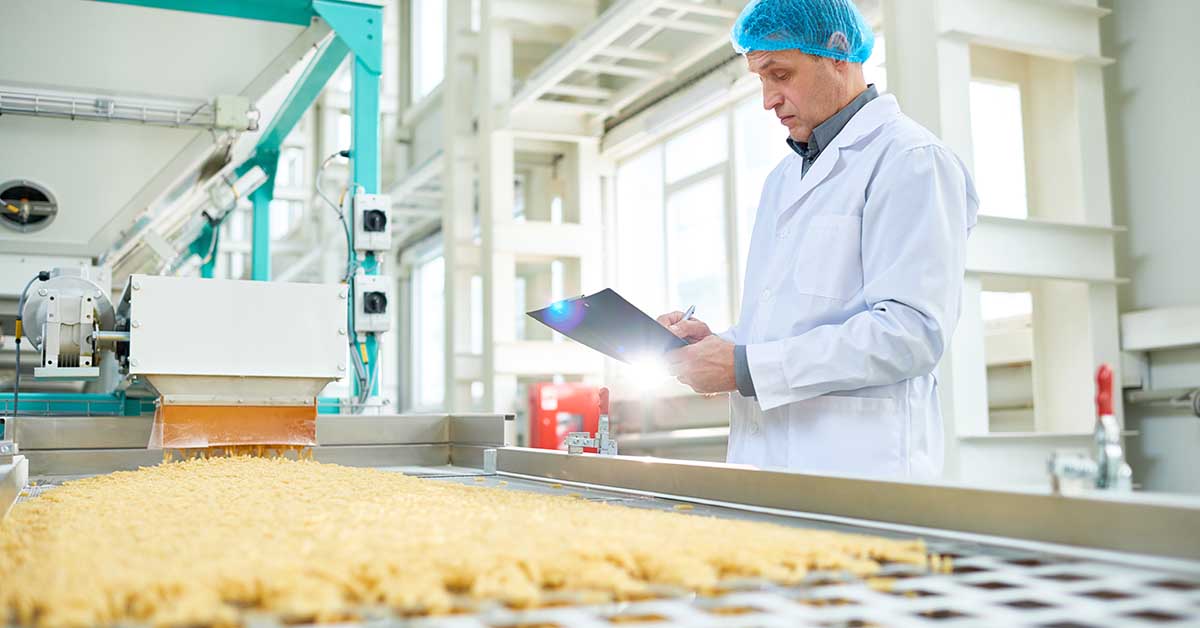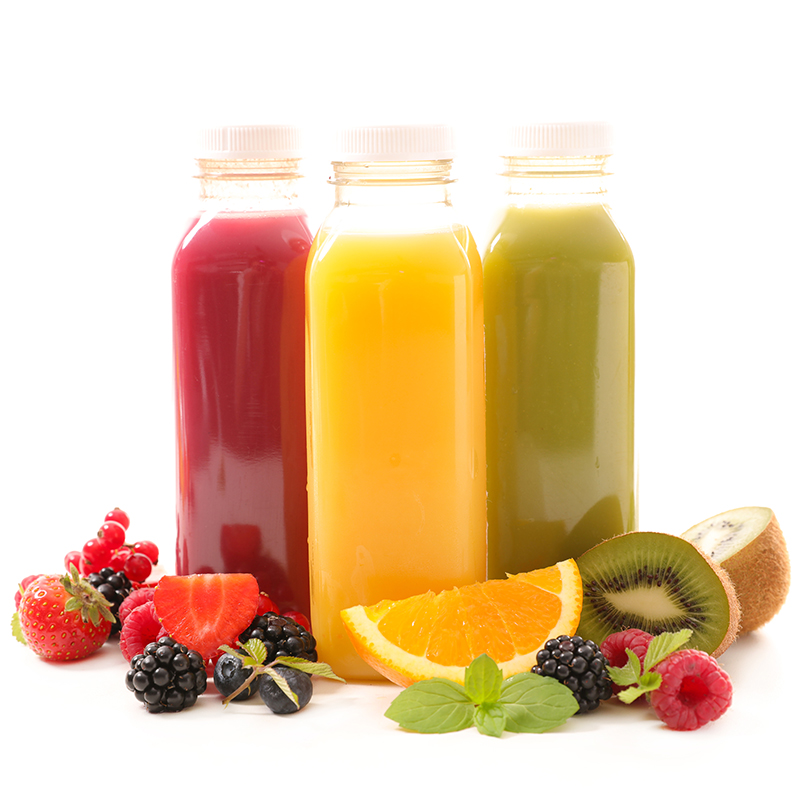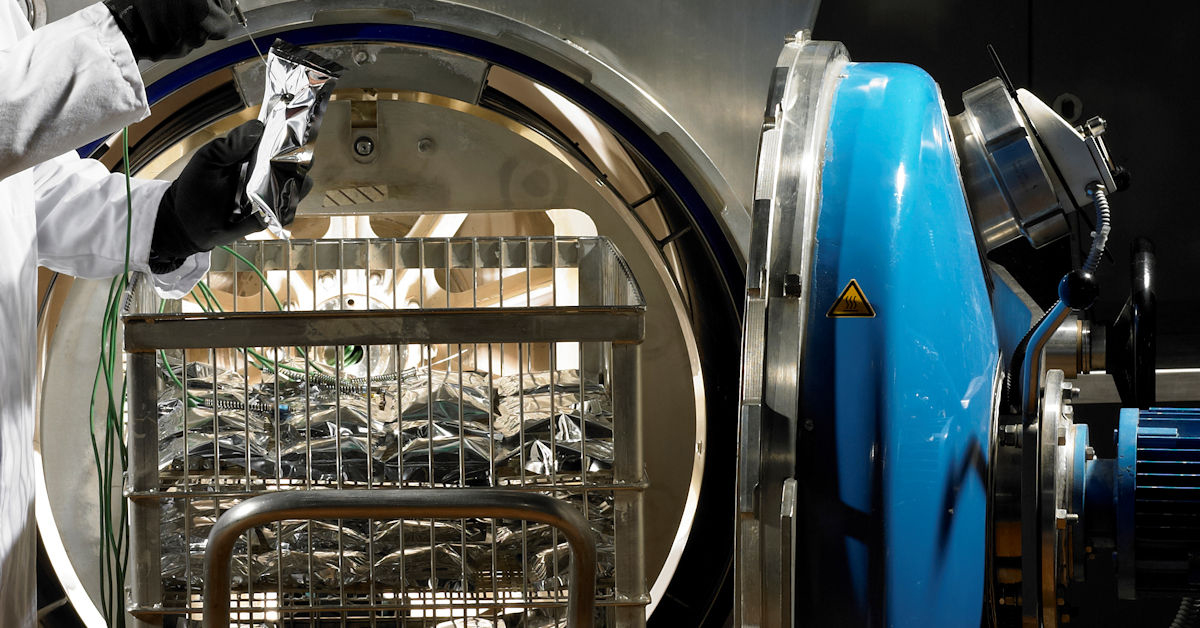
New ingredients, new processes: managing established risks
22 July 2024 | Mike Adams, Product Innovation Lead; Craig Leadley, Technology Fellow; Helen Arrowsmith, Regulatory Affairs Manager and Allergen Specialist; Sabina O’Reilly, Project Manager - Microbiology Safety and Spoilage.
The quest for innovation and new product development is getting more intense and, with the adoption of new ingredients and processing technologies, food business operators need to be aware of the associated food safety risks so that they can deliver new products that are both safe and successful.
At IFE Manufacturing 2024, we held a ‘New ingredients, new processes’ conference on food safety considerations in innovation. Attendees heard from leading industry figures and Campden BRI experts on key hazards to consider for food safety risks in innovation, practical measures for their control, as well as real examples and case studies.
We examined the risks presented by product, process and ingredient innovations across 3 key areas:
This white paper covers some of the insights shared during the conference.
Find out about more of our upcoming seminars, conferences and events. For information and support with your innovations, or with any of the challenges raised in this white paper, contact one of our experts.
Food and beverage product development
Supporting safe, successful innovations – helping you unlock value, potential and revenue through product, packaging and process innovation.

1. Cost optimisation
Costs are going up for manufacturers, meaning products are becoming more expensive to make. Consumers also have less money to spend, thereby making them more critical of their purchasing. As well as the severe inflationary pressure that supply chains have faced over recent times, global political turmoil, natural disasters and climate change are adding to the challenge and forcing manufacturers to adapt.
Optimising products within your portfolio is vital to maximise revenue and, for greatest effect, should be carried out proactively rather than reactively. Determining what consumers value about your product, and retaining or improving this while cutting costs, is crucial to keep your products viable and desirable.
Reformulation and reducing processing and/or storage costs are impactful approaches you can take to streamline costs while maintaining or improving the quality of your product. We explore both in this section.

‘Turning the dial on frozen’
There is pressure on manufacturers and retailers to reduce the environmental impact of their products and operations. Cost and affordability pressures have seen a consumer shift to buying more frozen food, but considerations around the cost of freezing and storing frozen foods remain.
In 1924, Clarence Birdseye – a key figure in Nomad Food’s history – invented a process that enabled Birdseye to provide consumers with high quality frozen food. Interestingly, after 100 years of frozen food production, the industry standard frozen food storage temperature of -18°C has remained unchanged and unchallenged.
This is where Nomad Foods saw a cost optimisation and sustainability opportunity. They came to us with the challenge to help them answer a really important question: Can frozen food products be stored at a higher temperature (than the -18°C industry standard)?
Key considerations included whether it is lawful to do so, as well as to ensure the food products remain safe and of consistent quality at higher temperatures. In addition, we aimed to find out whether storing frozen food at higher temperatures could facilitate a drop in energy consumption, leading to lower greenhouse gas emissions and cost savings.
We brought together various disciplines from across our expert teams – regulatory, product innovation, microbiology, sensory and nutrition – to support Nomad Foods with this venture.
The first stage of this comprehensive project was a regulatory review, to confirm whether or not there were any laws that would prevent a departure from the industry standard freezing temperature of -18°C. The regulatory mapping of both the UK and Europe provided Nomad Foods with the necessary understanding of relevant current legislation and where temperature change could feasibly happen in the more immediate future. Across most of Europe, legislation already allows us to increase the temperature to -15°C. In the UK, the requirement for -18°C only applies to products labelled ‘Quick Frozen Food’.
Testing at -9°C, -12°C, -15°C and -18°C includes microbiological, sensory, nutrition, quality (including texture and oxidative rancidity), packaging, and energy usage.
At the time of the conference, key figures included:
- 33 experts working on the project;
- 8 individual tests performed each month;
- 3000 micro data points;
- 9000 total data points.
Results show:
- Microbiology – products are safe at all temperatures;
- Sensory – all products at -15°C at parity with those at - 18°C;
- Nutrition – no downward trend at any temperature tested;
- Texture – no change at any temperatures tested;
- Oxidative rancidity – no change at any temperatures tested;
- Packaging – structure & functionality retained at all temperatures tested (only box products tested);
- Energy usage – for every 3°C increase in temperature there is a drop of 10-11% in energy consumption, and a similar level of greenhouse gas reduction.
Georgios Tetradis-Mairis of Nomad Foods, joined by Rupert Ashby of the British Frozen Food Federation (BFFF), talked conference attendees through this project and its results, highlighting the way we can work together to deliver significant savings in energy use without compromising safety or quality.
The findings could have a profound impact on the frozen food industry as a whole, supporting decarbonisation and sustainability agendas. Nomad Foods are working to establish an industry alliance in frozen to put the findings into action and, hopefully in time, pursue universal adoption. They are aiming to bring together retailers, customers, other FMCGs, white goods manufacturers and trade bodies to help push this project forward and drive change.
Safe replacement of ingredients
There are lots of reasons to have to use new ingredients.
Many food business operators proactively undergo value optimisation projects (to maximise efficiency, enhance product quality, reduce cost and meet consumer demand), which often involve recipe reformulation. There are also a number of general industry pressures, such as government measures (legislation, fiscal measures and voluntary schemes), cost pressures (both for operations and materials), market / consumer trends (e.g. for more sustainable products, plant-based alternatives, more free-from options, and considerations around ultra-processed foods; UPFs) and supply chain trends (e.g. new suppliers and emerging manufacturing technology), which all push food business operators towards reformulation and the use of new ingredients.
Balancing cost, availability of ingredients, nutritional profile, taste, product shelf-life and regulatory considerations can be challenging, especially when product development teams are redeveloping a product that they themselves may not have originally developed.
Key considerations for food safety tend to fall within the three broad categories of microbiological, physical and chemical safety, and ingredients will impact on all three.
Ingredients themselves can be split into 2 categories in terms of their role with respect to food safety. These are:
- Primary food safety ingredients – there to improve or assure the safety of a product (this category includes sugar, salt, preservatives and acidulants).
- Secondary food safety ingredients – which are everything else (ensuring that these ingredients are themselves safe is just as important as ensuring that active / primary ingredients are present).

Some of the main drivers for reformulation include:
- Cost – With the severe inflationary pressure that supply chains have faced over the past 24 months, cost optimisation is a key tool to examine the requirement for ingredients within a formulation and find opportunities to cut costs. Cost optimisation can also apply to packaging which, too, can be a critical food safety issue. It is important to consider the risk that cheaper ingredients / materials may be cheaper for a nefarious reason.
- Health and nutrition – There are pressures on the food and drink industry to reformulate products to improve their nutritional profile. This typically involves reducing sugar, fat and salt (all 3 of these can have implications on the safety of products).
- Market / consumer trends – New trends and drivers for ingredient replacement are emerging constantly in the dynamic food and drink industry. Plant-based demand, veganism, clean label, the ultra-processed food debate and sustainability are all significant drivers of innovation and ingredient replacement in the industry at the moment.
- Supply chain challenges – Supply chains continue to face significant pressure, and limited supply of ingredients can lead to both quality variation and elevated cases of food fraud. Alternative suppliers may be required to be identified at short notice, or existing suppliers may enforce changes that affect what they supply. Whilst ingredient specifications may remain the same, the BRCGS Global Standard for Food Safety is clear that this contingency must be covered by risk assessment.
Mike Adams, Product Innovation Lead at Campden BRI talked conference attendees through a number of case studies for all of these examples.
With the right understanding and care, all ingredients can be safely replaced, reduced or removed from food and drink products. It is critical, however, to ensure that what makes your product safe is fully understood, including the role of each of the ingredients and the impact of adjusting formulations or removing / swapping out any of them.
Furthermore, complex supply chains require complex effort to ensure safety, so you need to ensure that food safety is considered across all parts of the business. Understanding what each material is bringing to your product, and having detailed understanding of your supply chains, will enable you to successfully put in place several contingency plans based on the supply chain information – essential to ensuring continuity of supply of safe, quality products.
2. Clean label
There is no official definition for ‘clean label’ and perceptions of its meaning vary across both industry and consumers. A blog from the Institute of Food Technologists (IFT) defined clean label as “making a product using as few ingredients as possible, and making sure those ingredients are items that consumers recognize and think of as wholesome— ingredients that consumers might use at home”.
As for any type of reformulation exercise, ‘clean label’ innovations require developers to strike the right balance between cost, availability of ingredients, nutritional profile, taste, product shelf-life and regulatory considerations. As discussed in the ‘safe replacement of ingredients’ section, there is a need to understand what makes your product safe, the role of each ingredient and the impact of changing or removing any of them.
The choice of processing and packaging also needs to be factored into this balance. In this section of the conference, as well as looking at innovations in ingredients, we covered how different processing technologies can be used to achieve safe clean label formulations with the desired shelf-life.
The use of multifunctional ingredients to improve food safety
Bert de Vegt of Kerry Foods talked conference attendees through the science and applications of some of their exciting innovations for delivering the desired / extra shelf-life for a product whilst also catering to label-conscious consumers (by replacing e.g. sorbates and lactates with their products).
Examples included:
- Delaying spoilage in fresh ground poultry;
- Kerry’s ‘Innovation concept’ product that gives 11 days extra life (compared to using the ingredient being replaced – most commonly lactates).
- Yeast and spoilage control in salad dressings;
- Unsing Kerry’s ‘Nourishield D4040’ product that gives 336 days extra life (compared to using the ingredient being replaced – most commonly sorbates).
- Pathogen control and spoilage delay in frankfurters;
- Using Kerry’s ‘Nourishield D4040’ product that gives 10 days extra life (compared to using the ingredient being replaced – most commonly lactates).
- Sustainability – value of extra days in poultry;
- Presenting data on the waste reduction and other sustainability metrics associated with being able to extend the shelf-life of poultry products.
It was highlighted that it is often necessary to use combined technologies / products to meet desired goals for clean label products.
Clean label by process
Despite the confusion around terminology for clean label it seems likely that demand will continue to grow. Craig Leadley, Technology Fellow at Campden BRI, therefore took conference attendees through how different processing technologies can be used to achieve safe clean label formulations with the desired shelf-life.
In achieving the safe production of these products, traditional thermal preservation technologies are expected to continue to play a foundational role. Electrification of preservation technologies looks set to facilitate clean label whilst improving sustainability. Likewise, non-thermal technology uptake is likely to continue to grow (particularly in high-value, niche products). Plus, emerging technologies could see us entering an age of nature-identical, more sustainable food production.

Thermal processing
Thermal processing technologies include traditional examples such as pasteurisation, UHT and retorting as well as electrified rapid heating techniques such as microwave heating, ohmic heating and induction heating. Craig noted that just because these technologies are well established, it does not mean they should be overlooked – they are very powerful tools that manufacturers can use to achieve the required shelf-life whilst minimising the use of preservatives.
Electrified heating
When producing clean label products (just as when addressing many other of the challenges or opportunities in the food and drink industry), there can be trade-offs and tensions between different solutions. For example, developing a clean label product may come with the food safety considerations of removing preservatives. Or a developer may be aiming to produce a more sustainable product, but removing preservatives could result in more waste. Induction heating is an example where both the sustainability driver AND the need for clean label work together.
Induction heating technology uses a wound metal coil (similar to the induction hobs used domestically), which is electrically powered, and a heated metal element, which then heats the product. Industrial processing with induction heating involves the powered coil being wrapped around a pipe with the flowing liquid inside. The induction coil heats the heating applicator (the element inside the pipe), which heats the liquid in the pipe. The heating applicator also acts as a mixing device to ensure consistent heating, and provides a large surface area in a compact space to improve the heat transfer.
The improved heating efficiency can reduce start up times and shorten the length of the heating zone, which can reduce waste during operations on start up or recovery from stoppages. With up to 90-95% of the energy directly transmitted to the liquid being heated by induction heating, this technology can improve efficiency as well as reduce greenhouse gas emissions. Plus, the fast electrical responses allow tighter temperature tolerances to be maintained (which could lower manufacturers’ target temperatures, because these are typically set higher with steam-based systems which can be slower to respond).
Applications include trim heating, kettle boosting, as well as the heating of any liquid product for hot fill, UHT, or pasteurisation, such as of beverages, purees, sauces, stocks, bases and oils.
Non-thermal processing
In terms of non-thermal processing, both high pressure processing (HPP) and pulsed electric field (PEF) technology offer processing solutions to help achieve clean label products.
HPP is now a well established process for pasteurisation, can inactivate vegetative microorganisms, and is sometimes used to bring about desirable changes to the food. For many products (e.g. ready-to-eat vegetable meals, guacamole, dry-cured products, preservative-free sausages) HPP enables pathogen control and shelf-life extension (up to 3 times or greater compared to unprocessed products), both without preservatives and with minimal impact on sensory properties (can protect the degradation of natural ingredients that are thermally sensitive). Furthermore, as it is an in-pack process, it reduces the chances of product recontamination after processing.
PEF technology applies high electric voltage pulses to products to cause electroporation in cells. Lower electric field strengths can be used for inducing holes in larger cells like vegetable or meat cells (e.g. for extraction or improved drying). Higher electric field strengths are required for perforating small cells like microorganisms (for using PEF to decontaminate and pasteurise products). PEF provides a gentle means of pasteurisation compared to using thermal processing, but temperature can also be used to enhance the microbial inactivation achieved through PEF.
This gentler treatment can offer advantages such as improved colour retention. Thermally sensitive components like natural green colours (which would be discoloured by thermal methods) can be better protected with non-thermal technologies like PEF. For example, PEF application for a fruit smoothie with natural clean label colour from spirulina shows a better protection of the thermally sensitive blue/green colour, and PEF treated juice products are available in the cold shelves of several supermarkets.
Emerging techniques, such as gene editing, precision fermentation and cellular agriculture, may also be able to facilitate clean label, minimally processed and more sustainable products. Examples include producing non-animal dairy products (such as animal-free whey), nature identical colours and flavours, sustainable/ethical ingredients (e.g. palm oil produced from yeast fermentation) and gene edited crops (to boost nutrition, reduce allergens and delay spoilage).

3. Plant-based
According to a study in Science of the Total Environment, the proportion of people in the UK choosing plant-based alternative foods nearly doubled between 2011 and 2019.
Whilst the Vegan Society estimates that approximately 1-2% of the UK population follow a vegan diet, it is not only vegetarians and vegans who choose plant-based options when buying food and drink. Whether consciously choosing a ‘flexitarian’ diet, naturally following the trend of greater emphasis on foods derived from plants, or intentionally increasing the proportion of their diet that these products make up, consumers are continuing to be interested in plant-based alternatives.
Despite various media and trade press sources reporting a stagnation, or even decline in this space, plant-based food consumption is set to increase by 49% between 2024 and 2028 (according to Statista Consumer Market Insights). With plant-based products here to stay, it is important to highlight some of the food safety considerations for innovations in this category.
Plant-based food production often involves new ingredients or ingredients that wouldn’t normally appear in the traditional animal protein version of the product. As such, producers of plant-based products need to be mindful of the potential risks associated with, for example, food allergens and microbiological safety.
The allergen portrait of plant-based foods
Food allergy occurs when the immune system mistakenly treats proteins found in food as a threat and releases chemicals (against this perceived threat), which cause the symptoms of an allergic reaction. Since food allergens cannot be removed from products once they are present, and generally cannot be destroyed by treatments typically used for killing microorganisms (for example, heating or high pressure processing), effective food allergen management — and accurate labelling and provision of information — is essential for ensuring the safety of food for consumers with food hypersensitivity.
For this part of the conference, Helen Arrowsmith (Regulatory Affairs Manager and Allergen Specialist at Campden BRI) took attendees through some of the key food allergen considerations pertinent to plant-based foods.
A Food Standards Agency (FSA) campaign which took place in March 2024 was discussed, where it was made clear that consumers should not rely on vegan claims if they have allergies to milk, fish, crustacean, mollusc and/or egg. This is because ‘allergen’-free and vegan are separate claims for different consumer groups; vegan claims relate to dietary suitability, i.e. composition, whereas a food allergen absence claim relates to the safety of the food for consumption by consumers with food hypersensitivity.
In the absence of a specific legal definition of the term ‘vegan’ in UK or EU law, general legislation around provision of safe food and labelling that does not mislead consumers is relevant. It is recognised that precautionary allergen labelling (PAL) relating to animal-derived food allergens is acceptable for products making a vegan claim, due to manufacturing practices resulting in cross-contact if a thorough risk assessment and been conducted and where the risk of unintentional allergen presence is real and cannot be removed.
Research conducted for the FSA found that 54% of those who react to products of animal origin have relied on products being labelled ‘vegan’ to indicate whether a food is safe to eat at least sometimes when buying packaged food. But 25% of consumers weren’t aware they should check for a Precautionary Allergen Label (PAL) statement on vegan food/drink to inform a decision on whether it’s safe to eat.
Aside from the potential risk of cross-contact with animal-derived food allergens, around 40% of the raw materials used in plant-based food products contain various allergenic compounds. Research has shown that the primary ingredients used in plant-based alternative food manufacturing are sourced from the following commodities:
- 40% from seeds and legumes;
- 19% from nuts;
- 17% from cereals;
- 10% are fruits and vegetables;
- 6% are fungi;
- 3% are seaweed.
Particular seeds, legumes, nuts and cereals are already listed in legislation in terms of food allergen labelling (for example, by the Food Information to Consumers Regulation (EU) No. 1169/2011, which has been assimilated into UK law). Different foods are implicated in causing hypersensitivity reactions in different geographic regions depending on each country’s feeding patterns, and this is why local legislation varies as to which allergens are listed in relevant legislation.
There are however many foods that people can be allergic to, which are outside of those listed in the legislation. In fact, according to an FAO/WHO meeting report, about 170 foods have been found to have an adverse effect in someone somewhere. Some of these foods are ingredients and substances whose use is increasing and changing with their use as plant-based alternatives, and the prevalence of allergic reactions – or at least the data surrounding these – is increasing.
Fruits and vegetables (e.g. kiwifruit), fungi and edible algae (e.g. seaweed) are all examples of emerging food allergens. The implications of their presence in plant-based products therefore needs consideration. Producers of plant-based products need to look at their food chains and assess, control and communicate their risks relating to food allergens.
Microbiological safety of plant-based meat alternatives
Unlike meat, plant protein (such as soybean, pea, wheat, fava bean, rice and mung bean) must be extracted and processed, and, to create a ‘meat-like’ structure, it must undergo texturisation. This processing of plant-based proteins creates different safety considerations for the final product, compared to considerations for meat products.
The risks around animal protein are well known and there are well-established processes for controlling and mitigating them. The practices for examining the safety of plant-based meat alternatives are currently based on their meat counterparts as there aren’t yet criteria for the plant-based alternatives.
Although plant-based alternatives mimic meat products, their safety risks could be different – as well as the processing differences, there are differences in the natural microflora between meats and their plant-based alternatives. So, a better understanding of the background flora of plant-based products is needed. We know that listeria is still a risk when producing ready-to-eat, plant-based meat alternatives but there is a need for the industry to better understand if there are other existing or emerging risks.
So, more work is needed to determine the relevant risks and appropriate control measures for the different types of plant-based alternatives available and in development.
Sabina O’Reilly (Project Manager in Safety and Spoilage Microbiology at Campden BRI) presented some of her and the Campden BRI team’s research in this area, which is already supporting the improved understanding that the industry needs to support producers of plant-based products.
How we can help
Our knowledge and expertise place us at the forefront of global scientific innovation in this sector. We can help you to anticipate and mitigate the challenges and risks associated with developing new products.
Our technical experts can support your initiatives for reducing costs and increasing efficiency and profitability. All whilst understanding, protecting and even improving the attributes that consumers value, and ensuring that products remain safe, of the right quality, and meet the desired shelf-life.
We can help you to develop clean label formulations that meet market need, by ensuring that you have the understanding, ingredients, processing and packaging to support a safe product that has the desired shelf-life and meets regulatory requirements.
Our expertise in product development, food allergens and microbiology enable us to provide comprehensive support in developing and producing plant-based products. We can help you to understand the implications of the current and emerging allergens in your plant-based products, and can review new formulations and ingredients to provide objective feedback on food allergen legislation, food allergen labelling requirements, and considerations regarding emerging food allergens.
We can support you in determining the microbiological risks associated with your plant-based products, determining the most appropriate target microorganism for process validation, conducting testing to evaluate shelf-life, and devising a routine monitoring plan of microbiological testing for your product.
No matter what our client challenge may be, we consistently deliver innovative solutions, helping clients to conquer their market with safe, successful products.

About Michael Adams
Mike has worked in the food and beverage industry since 2006. Before joining us at Campden BRI in 2016, Mike worked in technical, quality and R&D roles within Mission Foods, PepsiCo, and Holland & Barrett. Mike studied for a BSc (Hons) in Microbiology at the University of Manchester, graduating in 2005.
Mike’s team support various clients, providing innovation services, research and analysis across a wide range of products, using our state-of-the-art laboratories and pilot plant facilities.

About Sabina O'Reilly
Sabina Joined Campden BRI in 2019 as a laboratory technician in Microbiological Analytical Services after completing a BSc in Biological Sciences from the University of Plymouth.
Sabina is now working in Microbiology Safety and spoilage as a project manager specialising in challenge and shelf-life testing of a wide range of food and drink products.
Sabina is a Research Scientist MRes apprentice with Aston University which involves conducting a multidisciplinary research project focusing on the safety, quality, and functionality of plant-based meat alternatives.
White paper download
Click below to download a copy of the white paper in PDF format
How can we help you?
If you’d like to find out more about product development and managing established risks, contact our support team to find out how we can help.







